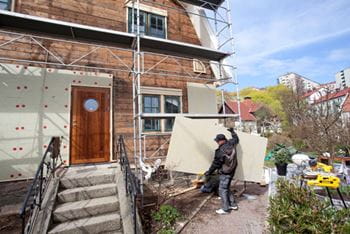Who would not want to live and work or spend their free-time in a building that is always at a correct and pleasant temperature? Unfortunately, that comes with a cost - during the cold months, buildings must be heated and, in the summer, cooled. That consumes energy and produces CO2 emissions which accelerate climate change.
CO2 is the most significant of the greenhouse gases impacting global warming. In fact, buildings cause a substantial amount of Europe's CO2 emissions, approximately 36 per cent. And naturally energy consumption also brings costs - for homes, companies and the society.
High-quality insulation ensures the energy efficiency of new buildings

We can influence the energy efficiency of buildings already at the design stage by making the right energy and building material choices. The most important part of energy efficiency for buildings is, however, proper and sufficient insulation. Of all the energy saving options for buildings, 80 per cent can be achieved through insulation.
The importance of improving the energy efficiency of buildings for the benefit of reducing climate change, energy consumption and costs has been widely acknowledged in Europe, and national and EU level obligations have been imposed for the energy efficiency requirements of new buildings. The comprehensive insulation of new buildings is becoming more common, and together with other energy saving measures, we can build, for example, low energy, passive energy, zero energy, energy neutral and energy-plus buildings.
Older building stock vitally important
New, energy efficient buildings are, however, only a part of the solutions since new buildings represent a mere one per cent of all building stock in Europe. In order to achieve significant impact, we must attend particularly to properties built before 1975, i.e. the time before the energy crisis. High-quality renovation achieved by adding extra insulation using, for example, stone wool to improve energy efficiency is vital in the attempts to lower energy consumption and reduce climate change as well as to increase living comfort and convenience.
Renovations must be increased to achieve climate objectives
Currently, approximately 1.2-1.4 per cent of Europe's existing building stock is renovated annually. However, economically we could increase renovations to three per cent of the building stock even by just following the normal repair cycle. This would have a significant impact on achieving the EU's energy and climate objectives. With regards to 2030, the aim is to reduce greenhouse gas emissions by at least 40 per cent and to increase energy efficiency by 32.5 per cent.
Do you live in a big house?
Did you know that by improving your home's insulation you will
• participate in reining in climate change,
• lower your energy bill and improve your property's energy efficiency rating,
• increase your living comfort - cooler in the summer, warmer in the winter and less outside noise and
• ensure the high-quality of your indoor air and lower the risk of mould problems.
By improving the energy efficiency of old buildings with extra insulation, it is possible to achieve 80 per cent savings in the energy consumption of a building depending on its age and condition at the time of renovation. This, undoubtedly, is an interesting piece of information for both individuals and those in charge of public premises. A usable and cost-effective way to increase energy efficiency does exist, let's use it!

Petri Viljanen
Sales Director, Building Insulation
PAROC
 We can influence the energy efficiency of buildings already at the design stage by making the right energy and building material choices. The most important part of energy efficiency for buildings is, however, proper and sufficient insulation. Of all the energy saving options for buildings, 80 per cent can be achieved through insulation.
We can influence the energy efficiency of buildings already at the design stage by making the right energy and building material choices. The most important part of energy efficiency for buildings is, however, proper and sufficient insulation. Of all the energy saving options for buildings, 80 per cent can be achieved through insulation. 